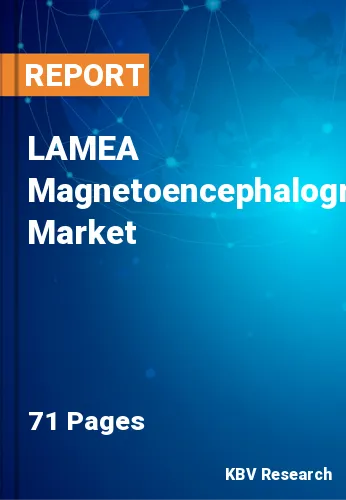The Latin America, Middle East and Africa Magnetoencephalography Market would witness market growth of 7.2% CAGR during the forecast period (2022-2028).
MEG recordings may be made on people when they are asleep. MEG does not generate any operational noise, unlike fMRI. In order to get accurate results from an fMRI scan, the patient must remain completely still during the recording process. However, the person need not be completely still to obtain accurate results from a MEG scan.
In conclusion, magnetic field electroencephalography (MEG) provides us with temporal features regarding brain activity with an accuracy of less than one millisecond, in contrast to functional magnetic resonance imaging (fMRI), which offers only limited temporal information. EEG, a technology complementary to MEG in terms of capturing brain activity, gives a spatial localization of neural activities; however, MEG provides more precise spatial localization of neural activities. Co-registration of EEG and MEG data is possible because of the equipment at the I-LABS MEG Brain Imaging Center.
It is possible to show the magnetic source on the structural MRI by using fiducial markers, structural magnetic resonance imaging (MRI), and core registration. This kind of imaging is known as magnetic source imaging. Imaging of magnetic sources may be used to study both naturally occurring magnetic activity and magnetic fields that are caused by external events. The most common use for MEG is for evaluating interictal epileptiform activity; in this way, it contributes to defining the irritative zone.
The population's health problems in the Middle East have been directly impacted by the numerous significant changes that have taken place in the region, just as they have in other nations throughout the globe. The World Health Organization (WHO) has released research on dementia that reveals an alarming growth in the frequency of dementia throughout the Middle Eastern area, which may increase 125% by the year 2050. Furthermore, in order to develop Dubai as a centre of excellence for healthcare in the area, the government of the UAE is working toward increasing the number of tourists who come to the UAE for medical treatment. In the LAMEA area, the demand for magnetoencephalography would likely increase as a result of all of these factors.
The Brazil market dominated the LAMEA Magnetoencephalography Market by Country in 2021; thereby, achieving a market value of $5,753 Thousands by 2028. The Argentina market is showcasing a CAGR of 7.7% during (2022 - 2028). Additionally, The UAE market would register a CAGR of 6.9% during (2022 - 2028).
Based on Application, the market is segmented into Clinical and Research. Based on Clinical Type, the market is segmented into Epilepsy, Dementia, Autism, Stroke, Multiple Sclerosis, Schizophrenia and Others. Based on End-use, the market is segmented into Hospitals, Academic & Research Institutes and Imaging centres. Based on countries, the market is segmented into Brazil, Argentina, UAE, Saudi Arabia, South Africa, Nigeria, and Rest of LAMEA.
Free Valuable Insights: The Worldwide Magnetoencephalography Market is Projected to reach USD 350.1 Million by 2028, at a CAGR of 5.1%
The market research report covers the analysis of key stake holders of the market. Key companies profiled in the report include Compumedics Limited, Ricoh Company, Ltd, FieldLine, Inc., MEGIN OY, CTF MEG Neuro Innovations, Inc. and Cerca Magnetics Limited
By Application
By End-use
By Country
Our team of dedicated experts can provide you with attractive expansion opportunities for your business.

